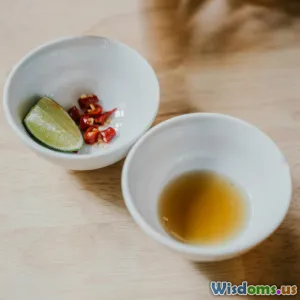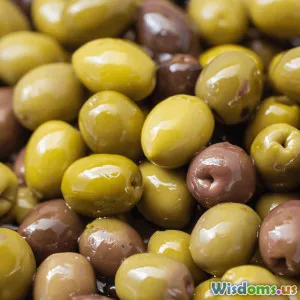
2024 Food Trends: Rise of Zero Waste Cooking in Kitchens
9 min read Explore the 2024 surge in zero waste cooking as kitchens embrace sustainability by transforming leftovers and scraps into delicious meals. (0 Reviews)
2024 Food Trends: Rise of Zero Waste Cooking in Kitchens
In an age where climate change and sustainability dominate global conversations, the culinary world is experiencing a radical shift. Enter zero waste cooking—2024's standout food trend that’s transforming kitchens from wasteful to resourceful hubs. This movement is not just about conserving ingredients but about redefining how we approach food preparation, consumption, and waste. From urban kitchens to Michelin-starred restaurants, zero waste cooking is capturing attention—and palettes—with its innovative, sustainable philosophy.
What is Zero Waste Cooking?
Zero waste cooking is a culinary approach focused on minimizing food waste by using every part of ingredients. Instead of discarding peels, stems, or “imperfect” produce, chefs and home cooks find creative uses for these components, turning potential trash into treasure. This practice goes beyond just leftovers—it reimagines kitchen operations by encouraging thoughtful purchasing, smart storage, and inventive recipe development.
In simple terms, zero waste cooking means:
- Utilizing all edible parts of food, including skins, stalks, seeds, and offcuts.
- Turning scraps into broths, sauces, or snacks.
- Creative preservation techniques to extend ingredient life.
Why Zero Waste Cooking is Trending in 2024
Several factors have accelerated the rise of zero waste cooking this year.
1. Environmental Urgency
According to the Food and Agriculture Organization (FAO), roughly one-third of food produced globally is wasted. This amounts to about 1.3 billion tons annually, contributing massively to landfill waste and greenhouse gas emissions. In 2024, efforts to combat climate change emphasize reduction of food waste as a key strategy.
2. Rising Consumer Awareness
Consumers are more informed about how everyday food choices affect the planet. Surveys reveal that 60% of shoppers want to buy more sustainable products and reduce waste at home. This ethical shift is pushing industry professionals to adopt zero waste solutions.
3. Economic Incentive
Food prices continue to fluctuate, making cost-efficiency crucial. Zero waste cooking can trim grocery bills by turning scraps into ingredients. Restaurateurs also benefit from improved profit margins by fully utilizing purchased stock.
4. Culinary Creativity
Chefs and foodies alike are embracing zero waste as a challenge to push their creativity. From carrot top pesto to watermelon rind pickles, zero waste cooking invites experimentation and rediscovery of ingredients.
Practical Applications of Zero Waste Cooking
Transitioning to a zero waste kitchen can seem daunting, but concrete practices bring this philosophy to life.
Utilize Vegetable Scraps for Broths
Save carrot peelings, onion skins, herb stems, and mushroom ends in a freezer bag. Once you have enough, simmer them into a flavorful vegetable stock. This reduces waste and adds depth to soups and sauces.
Root-to-Stem Cooking
Instead of tossing celery leaves or beet greens, incorporate them into salads, sautés, or pestos. Renowned chefs like Alice Waters and Dan Barber advocate such uses, spotlighting how often-overlooked parts harbor intense flavors.
Composting and Food Recycling
For unavoidable food scraps, home composting transforms waste into nutrient-rich soil. Furthermore, innovations like bokashi bins and worm farms provide options for urban dwellers without garden space.
Creative Leftover Transformations
Zero waste cooking encourages conscious meal planning and turning leftovers into new dishes. For instance, stale bread becomes croutons or breadcrumbs, while overripe fruit can be crafted into jams or smoothies.
Ethical Procurement
Buying "ugly" or imperfect fruits and vegetables supports zero waste by reducing agricultural waste. Some grocery chains and farmers’ markets in 2024 now dedicate sections exclusively to these items, often at discounted prices. For example, Imperfect Foods is growing rapidly as a delivery service focused on such produce.
Real-world Examples: Chefs and Restaurants Leading the Way
The zero waste cooking trend isn’t confined to home kitchens.
Silo, Brighton (UK)
One of the pioneering zero waste restaurants, Silo operates a policy of sourcing ingredients with zero packaging and uses whole animals and plants. Head chef Douglas McMaster emphasizes doing "as little damage as possible" in food creation.
SingleThread, California (USA)
Michelin-starred SingleThread integrates farm-to-table zero waste principles by raising its own produce and livestock. It incorporates every part daily into dishes, reducing external waste while promoting seasonal eating.
Local Community Initiatives
Community kitchens and apartment building co-ops in cities like Amsterdam and Toronto organize workshops teaching residents how to minimize kitchen waste, turning food scraps into compost or fermented ferments, showing rising societal adoption.
Tips for Embracing Zero Waste Cooking at Home
You don’t need to be a professional chef to waste less. Here are practical tips to start your zero waste cooking journey:
- Plan meals carefully to avoid buying excess ingredients.
- Store food properly to prolong freshness; for instance, use glass containers and beeswax wraps.
- Freeze leftovers or excess produce to reduce spoilage.
- Experiment with unconventional parts like broccoli stems or citrus peels; they add texture and flavor.
- Keep a scraps jar in the freezer for stock-making.
- Buy in bulk avoiding packaging waste, and bring reusable bags.
The Environmental and Social Impact
Adopting zero waste cooking on a larger scale can reshape our food systems. Environmental benefits include reducing methane emissions from landfills and conserving resources used in production. Additionally, less food waste correlates with improved food security.
Socially, this trend encourages mindfulness around consumption and promotes an ethos of respect for the labor and resources behind every meal—fostering healthier eating habits and community connection.
The Future of Zero Waste Cooking
The zero waste ethos is expected to deepen in 2024, infiltrating food technology with innovations such as apps that track fridge inventories to minimize waste, and upcycled food products using by-products—for example, beer made from surplus bread.
Educational institutions are incorporating zero waste practices into culinary teachings, ensuring a new generation of chefs is versed in sustainability.
Government policies are also aligning with these goals, incentivizing sustainable shopping and waste diversion.
Conclusion
Zero waste cooking is more than a seasonal fad—it's a pivotal step towards sustainable living that challenges our culinary creativity and moral responsibility. 2024 marks a cultural milestone where kitchens—both professional and domestic—embrace resourcefulness, reducing waste while improving flavor and economy.
By rethinking how we use ingredients and valuing every morsel, we contribute to a healthier planet and inspire others to do the same. Zero waste cooking invites us all to become stewards of food that honors nature’s abundance without adding to its burdens.
Are you ready to start transforming your kitchen into a zero waste zone?
Embrace the future of food—creative, sustainable, and delicious.
Rate the Post
User Reviews
Popular Posts




















